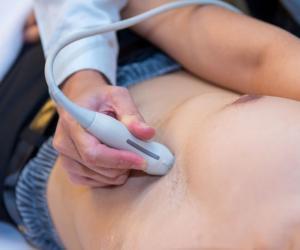Umbilical Hernia: Get the Facts

The umbilical cord is the cord that joins the fetus to its mother in the womb. This cord passes through a small opening in the abdomen which usually closes after birth. However, when stomach muscles don’t join completely, internal organs or intestines may bulge through this weak opening. This leads to what is known as an umbilical hernia. Usually, umbilical hernias do not cause any pain or discomfort, especially in children. According to Johns Hopkins Medicine, about 90% of umbilical hernia heal on their own. However, if umbilical hernias do not heal by the age of 4, treatment may be required.
As we have discussed, umbilical hernia is generally found in children, most predominantly infants, but it can also affect adults. It is not much different from a hernia, in fact, the basics of a hernia are the same. In umbilical hernia, it basically contains organs from the abdomen that are wrapped into a sac made up of three layers. The first and the innermost layer are called the peritoneum, the second layer contains abdominal muscles, and the third which are also the last layer is the skin.
Causes of Umbilical Hernia
An umbilical hernia is caused when the opening in the stomach through which umbilical cord passes doesn’t close completely. According to the Mayo Clinic, this type of hernia is most common in babies, but can occur in adults too. Premature babies, African-American babies, or babies that have extremely low birth weights are more prone to this condition.
Babies inside the uterus are fed through umbilical cord which connects the placenta to the baby’s abdominal muscles and this opening after birth forms the umbilicus. Sometimes this opening does not get covered fully after birth by muscles thus leaving the area weak and due to this weakness of the area slightest of the pressure in the abdominal region can push the organs through the umbilicus. Small hernias tend to heal themselves and may gradually close but the large ones, on the other hand, have to be operated surgically as they do not close themselves spontaneously.
In adults, umbilical hernias usually occur when too much pressure is applied on a weak section of the abdomen. This pressure can be caused by the following factors:
- Obesity
- Multiple pregnancies
- Having multiple babies at once (twins, triplets, etc).
- Stomach surgery
- Fluid in the abdominal cavity
- Persistent, strenuous cough
- Heavy weight lifting
- Heavy load during the delivery period
- Tumor in the abdominal cavity
Symptoms of Umbilical Hernias
An umbilical hernia tends to become noticeable when a baby is laughing, crying, or straining while passing bowels. Parents may notice a bulge protruding through the baby's belly that is not visible when the baby is in a relaxed position. The following are some other symptoms of umbilical hernias in all ages that can be serious and require immediate medical attention:
- serious pain
- the abdominal bulge is swollen, tender, or discolored
- vomiting
Particularly in adults, the most prominent sign of the umbilical hernia is the bulging of skin and skin protrusion at the navel region i.e. at the umbilicus. The bulge may be about 1 to 6cm in diameter. This bulging of skin can be even bigger and tends to increase in size during the activities like coughing, sneezing, lifting weight and much more. Color of the skin can be red, yellow or blue.
Diagnosis of Umbilical Hernia
To diagnose an umbilical hernia, a doctor typically performs a physical examination in both babies and adults. Sometimes an umbilical hernia can be pushed back inside the body easily and without requiring any other treatment. This is the first resort, as well as an examination to see if the hernia has been strangulated. Strangulated hernias can be very serious as they can cut off the blood supply to the area, so diagnosing them as early as possible is very important.
Surgery is the most efficient treatment for umbilical hernia and is most commonly performed under general anesthesia. In the surgery, after making an incision in the front wall of the abdominal cavity, the surgeon pushes the protruding tissues and organs into the abdominal cavity, and subsequently ties the muscles with stitches.
If the umbilical hernia is left untreated it can cause life threatening conditions such as laceration or strangulation. However, it is uncommon for the condition to progress to these states without symptoms causing serious discomfort to the patient, signaling for them to seek treatment.
Complications Associated with Umbilical Hernias
While most of the complications arising from a umbilical hernia are very rare, they can be serious, as in the case of a strangulated hernia. Intestines that are not able to be reduced (pushed back in) may not receive adequate a blood supply. This may cause severe pain and may result in the death of tissues (gangrene). Moreover, if the intestines are obstructed in any way, immediate surgery may be required.
Symptoms of a strangulated umbilical hernia include:
- fever
- severe abdominal pain
- constipation
- tenderness in the abdomen
- a bulging or round abdomen
- vomiting
- discoloration or redness of a hernia
Treatment of Umbilical Hernia
Umbilical hernias often heal on their own without any treatment but may require surgery if they do not resolve themselves naturally. Before performing a surgical operation to repair a hernia, doctors will typically wait until a hernia:
- is bigger than one-half inch in diameter
- is painful
- doesn’t reduce in size after one year
- doesn’t disappear by the time a child is 4 years old
- becomes strangulated
Preparing for Umbilical Hernia Surgery
Patients can drink fluids up to three hours before this particular surgery. It typically takes about an hour and is fairly painless, because the area is numbed well with anesthesia. An incision is made by the location of a hernia, and intestinal tissues are pushed back through the abdominal wall. The opening is then closed with stitches. The surgery is then deemed complete and some precautionary measures are often recommended by a patient's doctor. These recommendations may include staying home from work or school for a few weeks post-surgery and only using a sponge bath for the first 3-4 days, or as recommended.










